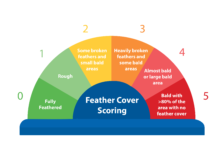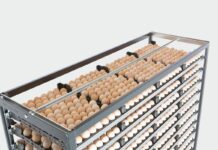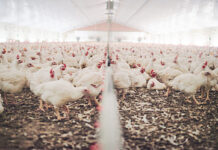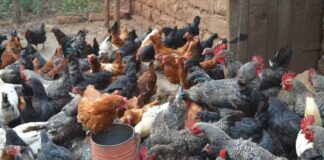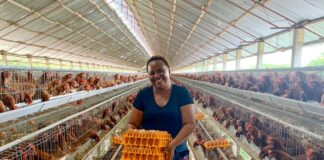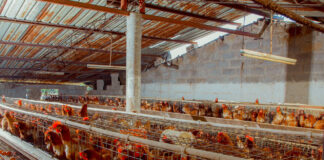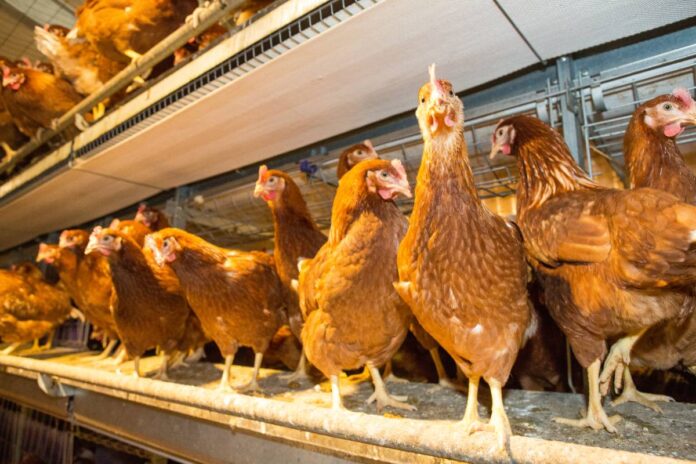
Modern poultry farming is seeing a significant shift towards higher welfare standards. This is due to the demand of the public for welfare-friendly products and to ensure the sustainability of the poultry industry.
The Five Freedoms have been the basis of animal welfare since the 1960s. It states that animals are in a good state of welfare when they have freedom from hunger and thirst; freedom from discomfort; freedom from pain, injury, and disease; freedom from fear and distress; and freedom to express normal behaviors (FAWC, 2009). Laying hens are motivated to perform normal behaviors such as perching, stretching, pecking, scratching, nesting, and dust bathing. One method of ensuring the welfare of laying hens by allowing them the freedom to express normal behaviors is through providing sufficient space and appropriate resources. The laying hen industry is adopting alternative housing systems like aviaries, which offer more space and resources than conventional cage systems. Intending to provide freedom and opportunity for laying hens to express behaviors and enhance welfare, the European Union (EU) directive took a significant step by banning the use of conventional battery cages from 2012 onwards (Council Directive, 1999).
A key component of the alternative housing system is perch provision. Perching is the antipredator behavior observed in wild fowl (Gallus gallus) that involves perching on elevated structures like tree branches (Newberry et al., 2001). This behavior persists in domestic fowl (Gallus gallus domesticus) such as cage-free laying hens despite their domestication in indoor housing systems in the absence of non-human predators (Figure 1) (Newberry et al., 2001). Perching is a highly motivated behavior in hens which is supported by compelling evidence indicating that hens showed signs of agitation when perches were inaccessible (Olsson & Keeling, 2000). Additionally, the strong motivation for roosting is highlighted by research demonstrating that hens actively utilized a push-door to access a perch (Olsson & Keeling, 2002).
PERCHES
An adequate perch for laying hens refers to one that birds can grip with their feet securely, providing a vantage point for observing the surroundings, and is elevated to promote natural roosting behavior (EFSA Panel on Animal Health and Animal Welfare (AHAW), 2015). Hens use perches to sit, stand, rest, or sleep. The provision of elevated perches is a priority for laying hens (Olsson & Keeling, 2002). But merely offering perches is not sufficient for welfare enhancement; perches must be provided in a way that ensures equal and easy access for all hens (EFSA Panel on Animal Health and Animal Welfare (AHAW), 2015). According to Council Directive (1999), the minimum standards for the protection of laying hens were set including the perch-related requirements, which are as follows:
- Provision of adequate perches
- Perches without sharp edges
- Perch space of at least 15 cm per hen
- Perches must not be mounted above the litter
- The horizontal distance between perches must be at least 30 cm and the horizontal distance between the perch and the wall must be at least 20 cm.
PERCHING IMPACTS
Over the years, many studies have been conducted to evaluate the effect of rearing with and without perches, and its impact on the birds’ health and welfare. The use of perches during the rearing environment has shown both beneficial and adverse outcomes.
Perches are vital for the physical development of birds, as they encourage jumping and flying behaviors, thereby supporting their overall fitness and growth (Campbell et al., 2016). Hens provided with perches typically have stronger bones compared to those without access to perches (Fleming et al., 1994). The use of perches contributes to skeletal development and increases leg bone strength and muscle growth in birds through continuous movement in the perches (Kiyma et al., 2016; Leyendecker et al., 2005). Hens with perch access compared with no perch access during the egg-laying period effectively reduced abdominal fat deposition (Jiang et al., 2014). Perch usage lowers floor stocking density and improves foot health and cleanliness (Kiyma et al., 2016). Furthermore, the provision of perches reduces the level of aggression and fear within commercial laying hen flocks (Donaldson & O’Connell, 2012); promotes the expression of positive comfort behaviors such as scratching, leg stretching, body shaking, wing fapping, (Chen et al., 2014); minimizes the occurrence of feather and vent pecking from aggressive and dominant hens; and ensures increased security (Gunnarsson, 1999; Kiyma et al., 2016). Utilizing perches led to increased body weight and body condition scores in hens while maintaining egg quality, feather coverage, foor egg proportions, and egg-laying performance (Donaldson & O’Connell, 2012). Hens raised without early access to perches have impaired spatial cognitive skills required for navigating three-dimensional spaces, which might affect later perching abilities (Gunnarsson et al., 2000). In essence, perches enable birds to engage in natural behaviors, thereby fostering their health and welfare (Pickel et al., 2011).
However, some major health and welfare concerns are related to perch usage. Introducing perches into a housing system has been found to impact two main issues: keel bone damage and footpad disorders (Hester, 2014; Käppeli et al., 2011). Damaged keel bone may be painful and affect the mobility of the hen (Nasr et al., 2012, 2013). Differences in the housing system are linked to differences in rates of keel bone damage. The prevalence of keel bone issues is high in alternative housing systems such as aviaries, as they provide greater opportunity and freedom to move and fy, posing a significant welfare challenge in contemporary laying hen farming practices, but is also present in conventional cage systems (Käppeli et al., 2011; Petrik et al., 2015; Wilkins et al., 2011). The tendency of increased risk of keel fractures is positively linked to the height of the perches (Wilkins et al., 2011), suggesting the considerable impact of collisions. Furthermore, perch usage can result in unstable footing while flying to/from perches (Scholz et al., 2014). Prolonged pressure load on the footpad can result in serious foot pad disorders including bumble foot and foot pad hyperkeratosis.
GENERAL CONSIDERATION ON PERCH DESIGNS
The way perches are built can significantly affect the perching behavior, welfare, and productivity of hens. When implementing elevated perches, accessibility is crucial. Good perch designs should allow hens to access the perch comfortably without restrictions, ensuring birds can fy or jump freely (Struelens & Tuyttens, 2009). Therefore, it is advisable to introduce stepwise perch designs or combine higher perches with lower levels to facilitate hen access to elevated perches. Perches should be easy to clean and disinfect (Sandilands et al., 2009). Furthermore, a well-designed perch should mitigate the risk of unstable footing and injuries such as bone fractures and keel damage (Scholz et al., 2014), thereby safeguarding the health and welfare of the hens and promoting their natural behaviors.
PERCHING MATERIALS
Diferent commercial perch materials are available in the poultry industry such as wood, steel, plastic, metal, vinyl padded, and polyurethane. Wood is commonly used due to its cost-effectiveness, but it poses challenges such as susceptibility to red mite infestations in the presence of cracks and holes and is often difficult to clean (Hester, P., 2014). Metal and plastic perches are easier to clean and are less prone to mite infestations with closed joints but can be slippery. Vinyl padded perches are favored by hens for their enhanced grip, providing better stability for hens (Struelens & Tuyttens, 2009). Polyurethane perches stand out for their efficacy in improving footing stability as evidenced by hens spending more time on polyurethane perches as compared to plastic and metal perches (Pickel et al., 2011). Moreover, perches with polyurethane have demonstrated potential in reducing footpad disorders and minimizing keel bone fractures and deviations (Stratmann et al., 2015). Therefore, the importance of perch material selection in promoting both the physical comfort and welfare of laying hens cannot be overlooked.
PERCH HEIGHT
The height of the perches is considered an important factor. Laying hens seek elevated perches during the day as well as at night. Hens prefer lower-height perches during the daytime and higher-height perches during the nighttime (Struelens & Tuyttens, 2009). The motivation to seek elevation is particularly strong at night when hens select a site for resting or sleeping. Perches of different heights for day and nighttime can help in promoting perching behavior. Higher perches help hens monitor the environment and avoid disturbances from the surroundings.
Research has shown that perch usage among laying hens tends to rise as the height of the perches increases (Brendler et al., 2014). Hens should be provided with perches that require no more than 80 cm to jump vertically, horizontally, or diagonally to reach or leave the perches (EFSA Panel on Animal Health and Animal Welfare (AHAW), 2015). Hence, careful consideration of perch height is vital to optimize perch usage.
PERCH SHAPE AND DIAMETER
Perches come in different shapes such as round, oval, square, and rectangular. The shape of perches have a significant impact on peak forces experienced by the keel bone and foot pad of laying hens (Pickel et al., 2011). Round and oval-shaped perches provide less contact area and exert higher peak pressure on the keel bone and foot pad than square or rectangular perches with sharp edges (Pickel et al., 2011). However, sharp-edged perches could contribute to signifcant footpad disorders, such as bumblefoot and toe hyperkeratosis (Liu et al., 2018). That is why the EU directive mandated that perches must not have any sharp edges.
Perches with higher diameters provide larger surface area for the attachment of keel bone and footpad with better stability in hens as compared to lower diameters (Pickel et al., 2010). A perch of width between 3 and 6 cm is recommended for better stability and to reduce peak force in the keel and foot pad (EFSA Panel on Animal Health and Animal Welfare (AHAW), 2015).
CONCLUSION
Enhancing poultry health and welfare through well-designed perching options is crucial. Educational programs aimed at producers should emphasize the benefits of perch utilization and the importance of optimal design. Poultry producers should prioritize the incorporation of adequate space and opportunities for perching within their housing systems. This aligns with the natural behavioral needs of laying hens and can significantly contribute to their welfare. Perching allows hens to exhibit instinctual behaviors, such as roosting and observing their surroundings, promoting a sense of security and comfort.
However, it’s not enough to merely include perches in poultry housing. Careful attention must be given to various factors during the design phase. The choice of perch material, its shape and height, and the overall space allocation are all critical considerations. These elements can impact not only the usability of the perches but also their safety and effectiveness in promoting natural behaviors and physical health.
References are available on request
By courtesy of The University of Tennessee Institute of Agriculture and UT Extension


